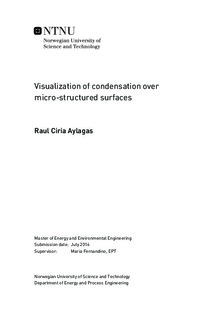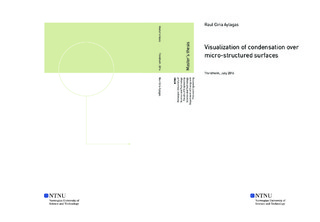| dc.description.abstract | Water condensation is an ubiquitous phenomenon that happens widely in nature. It is also used in industrial applications such as water harvesting, desalination systems, thermal management and power generation. Filmwise condensation is commonly found in nature, but dropwise condensation is preferred due to the higher heat and mass transfer coefficients and lower thermal resistance. However dropwise condensation is difficult to obtain and sustain, so micro- and nano-structured surfaces have been studied as the most promising way to achieve it. Bio-inspired surfaces designed mimicking natural surface structures have achieved high degree of superhydrophobicity and extraordinary characteristics like self-cleaning and low adhesion, but some disadvantages for the dropwise condensation process have been discovered as the reduction of heat transfer performance during nucleation and growing stages or the low durability.
One of the most important steps on dropwise condensation is the droplet removal before the flooding of the surface. Self induced out of plane jumping has been studied several times, but as the condensation process is run, it seems to be too slow to regenerate the surfaces and remove efficiently the droplets. Some additional mechanisms were studied to enhance this process as the electrostatic improvement of the droplet removal, but recently, a new promising mechanism has been reported for the first time.
The sweeping droplet removal mechanism shows that it s faster than the jumping droplet removal mechanism, but there is not enough experience or evidence around this topic.
The main objectives of this thesis are design and fabricate different microstructured surfaces for promoting dropwise condensation, enhancing the heat transfer performance, and the design and fabrication of an experimental setup for the visualization of the condensation process.
Fabrication of micro pillars procedure has been learned and improved in order to achieve maximum quality on them. The process consists of two steps of photolithography and dry etching using the photoresist SU8. The etching process with ICP-RIE Cryo is a very delicate step where some adjust has to be done to the parameters depending on the kind of pillars that we want to obtain.
Visualization of the condensation process under laboratory conditions was achieved in a proper way unless for samples with dimensions lower than 10μm. However dropwise condensation was not sustained and droplet removal has not been visualized anywhere. Another setup with allows more controlled conditions has been designed and made for further experiments visualizing the condensation process and even roughly measuring the heat transfer performance. | |

